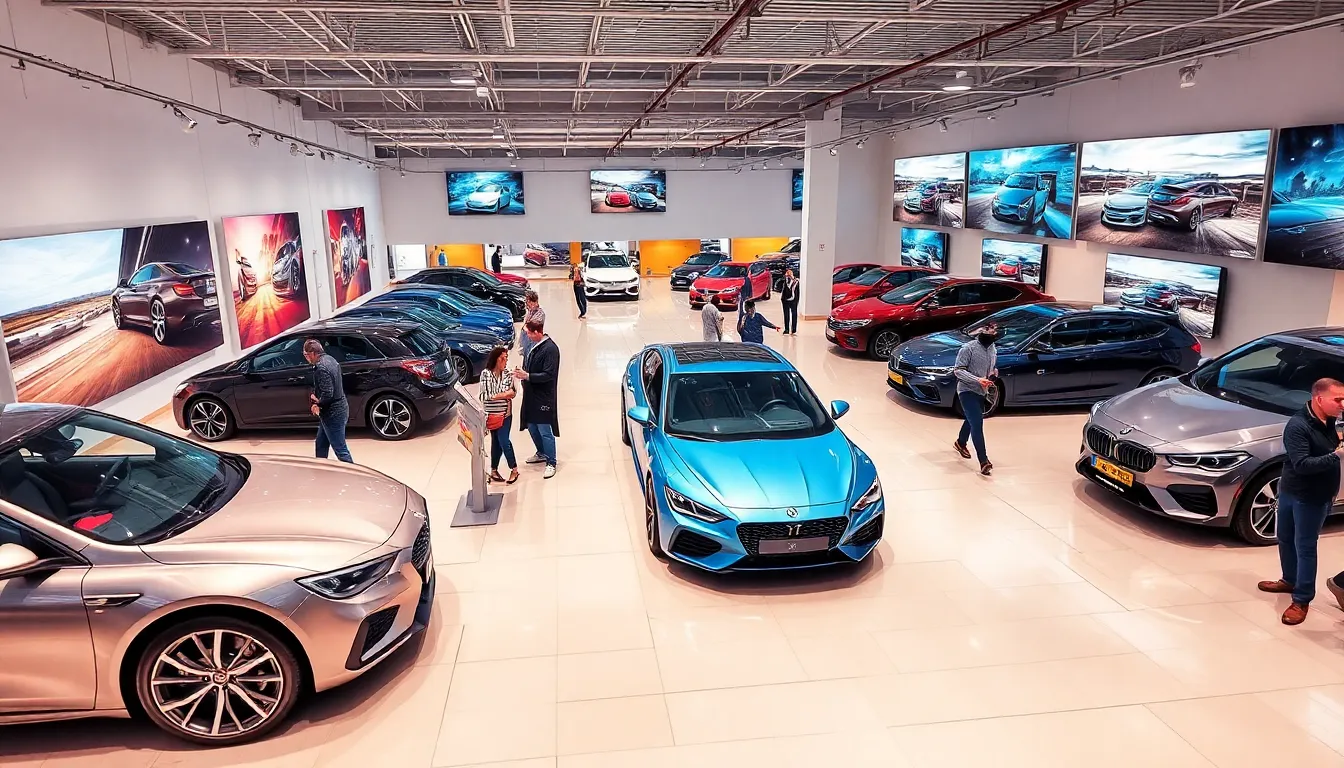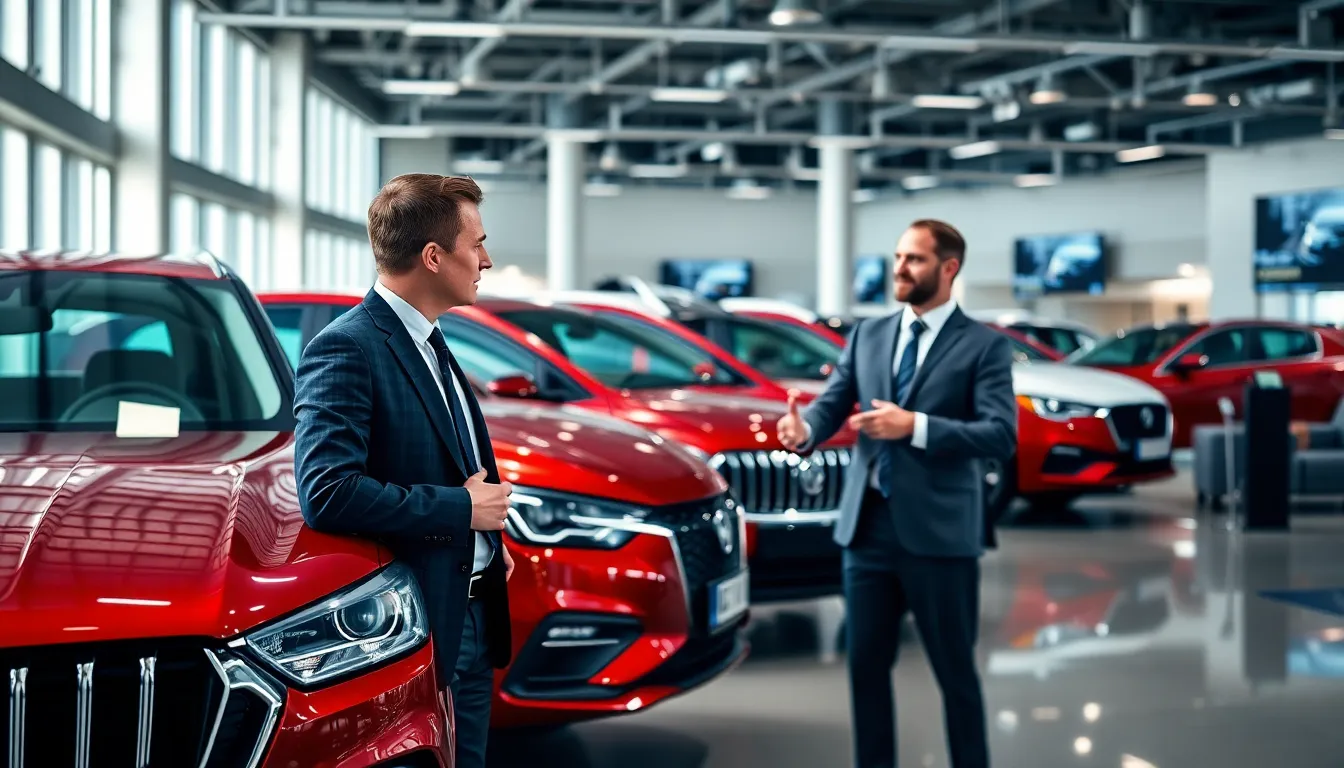Imagine stepping into a car showroom where every vehicle gleams like it just rolled off the assembly line. This isn’t just any ordinary display; it’s the enchanting realm of “car showroom mode.” Here, cars don’t just sit idly—they dazzle, beckoning potential buyers with an irresistible charm.
Table of Contents
ToggleOverview of Car Showroom Mode
Car showroom mode presents a unique ambiance designed for optimal vehicle presentation. This environment highlights each car’s features, ensuring that every detail stands out. It employs strategic lighting techniques to create a visually stunning display that captures buyers’ attention.
In addition, cleaning procedures keep all cars in immaculate condition, enhancing their appeal further. The arrangement of the vehicles encourages exploration, making it easier for potential customers to engage with the cars.
Commonly, showrooms utilize digital displays and interactive elements, allowing visitors to learn about vehicle specifications and features. Information displayed on screens supports deeper insights, encouraging informed decision-making.
Furniture and decor typically reflect a modern aesthetic, providing a comfortable setting for visitors. Employees trained in customer engagement welcome guests, guiding them through their experience. They answer questions and share knowledge about each model.
Effective use of space within car showroom mode ensures that the flow encourages customer interaction. By creating zones for different vehicle categories, showrooms help focus attention on specific options. Atmospheric music can enhance the shopping experience, making it more enjoyable.
Ultimately, car showroom mode aims to convert interest into sales by creating a memorable buyer experience. The atmosphere fosters excitement and representation of the brand, reinforcing potential purchases.
Key Features of Car Showroom Mode

Car showroom mode incorporates elements that enhance the vehicle presentation experience. This mode emphasizes user engagement, customization, and a visually attractive interface.
User Interface Design
User interface design focuses on creating an intuitive browsing experience. Visual elements guide visitors through vehicle options, allowing easy navigation. High-resolution images showcase vehicles from multiple angles. Interactive touchscreens enable customers to explore features at their convenience. Color schemes and layouts maintain a cohesive aesthetic, harmonizing with the showroom’s ambiance. Clear call-to-action buttons prompt users to schedule test drives or request additional information. Each design element contributes to a seamless interaction, enhancing the overall customer journey.
Customization Options
Customization options invite potential buyers to personalize their vehicle experience. In this mode, customers can select colors, interior materials, and additional features. Virtual reality tools offer immersive experiences, allowing buyers to visualize choices. Interactive displays engage visitors by showing real-time updates on selected modifications. Preferences can be saved for future reference or comparison. By presenting various options, customers feel empowered in their decision-making process. These features help create a tailored shopping experience that resonates with individual preferences.
Benefits of Car Showroom Mode
Car showroom mode offers numerous advantages that significantly enhance the vehicle buying experience. It creates an inviting atmosphere that captivates potential customers.
Enhanced Customer Experience
Engaging presentation environments elevate the excitement of vehicle exploration. Customers appreciate high-resolution images and touchscreens that simplify the browsing experience. Immersive virtual reality tools allow buyers to visualize options realistically. Personalized shopping experiences increase satisfaction, as customers select colors and features tailored to their preferences. Skilled employees foster relationships by providing informative interactions, addressing questions, and enhancing the overall customer journey. These elements collectively contribute to a memorable experience, making customers feel valued and understood.
Increased Sales Efficiency
Sales teams observe improved efficiency within this mode. Organized vehicle displays and strategic layouts direct customer attention effectively. Focused zones for different vehicle categories streamline navigation and decision-making. Enhanced exposure to vehicle features encourages more informed purchases. Integration of interactive displays engages customers and facilitates deeper understanding of specifications. As excitement builds, conversions from interest to sales become more seamless. Teams equipped with digital tools access real-time data, optimizing follow-up opportunities and accelerating sales processes. Ultimately, these factors drive revenue, making car showroom mode a vital strategy for dealerships.
Comparison with Traditional Showroom Models
Car showroom mode differs significantly from traditional showroom models. One primary distinction lies in the overall ambiance and vehicle presentation strategies. Traditional showrooms often prioritize a standard setup with limited engagement, whereas car showroom mode creates an immersive experience that captivates customers.
In traditional models, vehicles might be displayed in a conventional manner, leading to a less engaging customer experience. Car showroom mode uses modern aesthetics, including strategic lighting and organized layouts, which highlight vehicles’ features. Customers experience a visually appealing environment, encouraging them to explore and interact with the cars.
Employee training also contrasts sharply between the two models. Traditional showrooms may have staff focused solely on sales, while car showroom mode emphasizes building relationships through informed interactions. Employees in car showroom mode engage with customers, offering insights and fostering a connection that enhances the shopping experience.
Digital tools play a crucial role in both models, yet the execution varies. Traditional showrooms typically rely on static displays, while car showroom mode embraces interactive technologies. These technologies include virtual reality tools and touchscreen displays that allow users to customize their experience, enhancing engagement with vehicle options.
Moreover, space utilization showcases differing strategies. Traditional showrooms may lack distinct zones for various vehicle categories, which can lead to a disorganized experience. In contrast, car showroom mode utilizes effective space organization to guide customer attention and streamline navigation, making it easier for customers to find what they seek.
Ultimately, car showroom mode focuses on converting interest into sales through an engaging atmosphere. Traditional models may fall short in fostering excitement and facilitating informed decisions. By prioritizing interaction, personalization, and atmosphere, car showroom mode stands out as a modern retail strategy in the automotive industry.
Future Trends in Car Showroom Mode
Technology integration accelerates within car showroom mode, emphasizing virtual and augmented reality experiences. Customers now explore vehicle features through immersive digital displays. Interactive elements continue to captivate potential buyers, making vehicle selection more intuitive.
Sustainability gains prominence, influencing showroom designs and materials. Showrooms adopt eco-friendly practices, promoting electric and hybrid vehicles. Car manufacturers emphasize energy-efficient technologies, attracting environmentally conscious consumers.
Data-driven personalization becomes essential in enhancing customer experiences. Advanced analytics track preferences and behaviors, allowing tailored recommendations. Personalized marketing strategies foster a deeper connection between brands and customers.
Mobile solutions initiate a shift in how showrooms interact with potential buyers. Applications that enable virtual tours and simulations enhance accessibility and convenience. Customers engage with showrooms remotely, allowing for a seamless vehicle selection process.
Social media influence grows, with showrooms leveraging various platforms to reach wider audiences. Innovative campaigns promote customer engagement and brand loyalty. User-generated content allows satisfied customers to share their experiences and enhance showroom reputation.
Finally, the integration of contactless technology increases in significance. Showrooms embrace touchless interactions for a more hygienic experience. Digital appointments and remote consultations streamline the buying process, establishing customer trust and satisfaction.
Car showroom mode evolves through these trends, fundamentally transforming how potential buyers interact with vehicles and dealerships.
Car showroom mode represents a significant evolution in the automotive retail landscape. By creating an immersive environment that prioritizes customer engagement and interaction, it transforms the vehicle buying experience into something memorable and exciting. The strategic use of technology and design enhances the presentation of vehicles, making them more appealing to potential buyers.
As dealerships continue to embrace this modern approach, the focus on personalization and relationship-building will be crucial. With the integration of innovative tools and sustainable practices, car showroom mode is set to redefine how customers connect with vehicles. This strategy not only drives sales but also fosters lasting brand loyalty, ensuring that the automotive industry remains dynamic and responsive to consumer needs.



